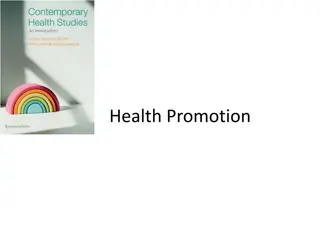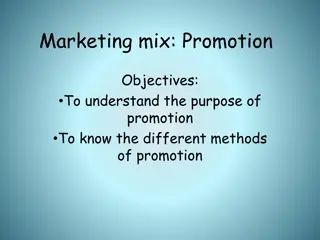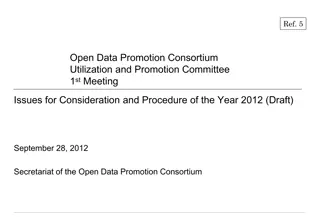Understanding Perspectives on Health and Health Promotion Models
Explore the various perspectives on health as seen through the eyes of different health professionals, understanding the root causes of health issues such as heart disease. Learn about the three models of health - biomedical, behavioral, and socio-environmental - and how they influence health promotion practices. Gain insights into different strategies to address health concerns based on these models.
Download Presentation

Please find below an Image/Link to download the presentation.
The content on the website is provided AS IS for your information and personal use only. It may not be sold, licensed, or shared on other websites without obtaining consent from the author. Download presentation by click this link. If you encounter any issues during the download, it is possible that the publisher has removed the file from their server.
E N D
Presentation Transcript
Approaches in Health Promotion Part 1 WEEK 4 LECTURE 3
Objectives: By the end of this lecture, you will be able to: Recognize the different ways of looking at health and the root causes of health and illness Explain how one s perspective on health influences the choice of strategies to address health issues. Exploring the three models of health that influence health promotion practice
Perspectives on Health: What causes heart disease? If you ask the same question to three different health professionals, you may get three different answers.
Perspectives on Health: Ask a cardiologist and she/he may tell you that: Heart disease is caused by hypertension, family history, and a build-up of arterial plaque.
Perspectives on Health: On the other hand, if you ask a public health worker, he/she may tell you that: Heart disease is caused by smoking, physical inactivity, excess alcohol consumption and a high fat diet.
Perspectives on Health: But, on the other hand, if you ask a social worker, social epidemiologist or anti-poverty activist, you may get the following answer: Heart disease is caused by stress, poverty, unemployment and social isolation.
What are the three models of health that influence health promotion practice? The biomedical model views health as the absence of diseases or disorders. 2. The behavioral model views health as the product of making healthy lifestyle choices. 3. The socio-environmental model views health as the product of social, economic and environmental determinants that provide incentives and barriers to the health of individuals and communities. These models represent three different ways of looking at health. 1.
Exploring the Three Models The following table illustrates the recommended course of action for addressing this issue suggested by each of the three models.
Exploring the Three Models 3 Approaches to Reducing Heart Diseases Health Model Causes of Problem Principles to Address Problem Biomedical Hypertension Family history hypercholesterolemia Treatment/ drugs Low salt/low cholesterol dietary regimen Behavioral Lifestyle Smoking High fat diet Low level of physical activity High stress levels Health education Health communication Advocacy for health public policy supporting lifestyles choices (e.g workplace smoking bands) Socio-environmental Living conditions Working conditions Social isolation Policy change Advocacy Community moblization
Useful links: http://health.tki.org.nz/Key-collections/Curriculum-in-action/Making- Meaning/Socio-ecological-perspective/Defining-health-promotion/Models- of-health-promotion
Main Approaches in Health Promotion Medical or preventative Educational Behavioral change Empowerment Social change
These approaches have different objectives: To prevent disease To insure that people are well informed and are able to make health choices To help people acquire the skills and confidence to take greater control over their health To change polices and environments in order to facilitate healthy choices
TOP-DOWN VS. BOTTOM-UP Priorities set by health promoters who have the power and resources to make decisions and impose ideas of what should be done Priorities are set by people themselves identifying issues they perceive as relevant
THE MEDICAL APPROACH Aim: Reduce morbidity and premature mortality Target: Whole populations or high risk groups Activities: Involves medical intervention to prevent or ameliorate ill-health
Stages of preventions: Primary prevention prevention of onset of disease, e.g. immunization; encouraging non smoking Secondary prevention preventing progression of disease, e.g. Screening Tertiary prevention reducing further disability and suffering in those already ill; e.g. rehabilitation, patient ducation, palliative care
The medical approach features: Uses scientific methods, e.g. epidemiology Prevention and early detection of disease is cheaper than treatment Top-down approach, i.e. led by experts, this kind of activity reinforces authority of health professionals who are viewed as having necessary knowledge to achieve results Highly successful examples in the past, e.g. eradication of smallpox
The medical approach features ( methods ) : Preventive procedures need to be based on a sound rationale derived from epidemiological evidence Having an infrastructure capable of delivering screening or immunization programs, e.g. Trained personnel, equipment and laboratory facilities, record keeping facilities, effective and safe vaccine
Evaluation of the medical approach: Short term evaluation Increasing in percentage of target population being screened or immunized Long term evaluation Reduction in disease rates and associated mortality
The medical approach pitfalls: Focuses on the absence of disease rather than on promoting positive health Based on a medical definition of health Ignores the social and environmental dimensions of health Encourages dependency on medical knowledge and compliance with treatments Removes health decisions from nonprofessional people
The Educational Approach Aim: To enable people to make an informed choice about their health behavior by: providing knowledge and information developing the necessary skills OUTCOMEis client s voluntary choice which may be different from the one preferred by health promoter
The Educational Approach (features): Aspects of learning: Cognitive Aspect (information and understanding) 2. Affective Aspect (attitudes and feelings) 3. Psychomotor Aspect (skills) 1. http://aview.in/allevents/learning-aspects
Aspects of Learning (methods): Cognitive Aspect - Provision of information about causes and effects of health-related behaviors Provision of leaflets/booklets Visual displays One-to-one advice Affective Aspect - Provision of opportunities for clients to share and explore their attitudes and feelings Support groups Group discussions Psychomotor Aspect - Deals with the skill of doing things. Practice essential disease management skills Group discussions
The Educational Approach (Evaluation): Increase in knowledge is easy to measure (exam, pre- post questionnaire..) HOWEVER, Knowledge alone is insufficient to change behavior Knowledge is rarely translated into behavior
The educational approach pitfalls: ASSUMES THAT: Increase in knowledge change in attitudes behavior change BUT: Voluntary behavior change may be restricted by social and economic factors Health related decisions are very complex
Behavior Change Approach Aim: Encourages individuals to adopt healthy behaviors which improve health Views health as a property of individuals People can make real improvements to their health by choosing to change lifestyle It is people s responsibility to take action to look after themselves Involves a change in attitude followed by a change in behavior
Behavior change approach (Methods): Campaigns to persuade people e.g. Not to smoke To adopt a healthy diet To undertake regular exercise, etc. Targeted towards individuals May use mass-media to reach them
Behavior change approach (Evaluation): Theoretically it would appear simple by asking: Has the health behavior changed after the intervention? However, there are two main problems Change may become apparent only after a long period Difficult to determine whether behavior change was due to health promotion intervention
The behavior change approach pitfalls: Depends on person s readiness to take action Complex relationship between individual behavior and social and environmental factors Behavior may be a response to a persons living conditions which may be beyond individual control (e.g. Poverty, unemployment)
Empowerment Approach WHO defined health promotion as enabling people to gain control over their lives (empowerment)
Empowerment Approach Aim: Helps people identify their own concerns and gain the skills and confidence necessary to act upon them Features: This is the only approach to use a bottom-up (rather than top-down ) approach Clients have the right to set their own agenda Health promoter plays the role of a facilitator rather than that of an expert, he/she initiates the process but then withdraws from the situation
Empowerment Approach Empowerment may involve both self-empowerment and community empowerment Self-empowerment: Based on counseling Uses non-directive ways Increase person s control over his/her own live For people to be empowered they need to: Feel strongly enough about their situation to want to change it Feel capable of changing the situation by having information, support and life skills
Empowerment Approach (Methods): Examples of methods used in empowerment approach: Nurses working with patients to develop a care plan Teachers working with students to raise their self-esteem
Empowerment Approach (Evaluation): Evaluation includes qualitative methods that reveal people's perceptions and beliefs , Quantitative methods that demonstrate the outcome such as behavioral change HOWEVER, Usually empowerment is a long term process Difficult to conclude that changes are due to the intervention rather than some other factor
The empowerment approach pitfalls: Results are vague and hard to quantify compared with those of other approaches Health promoter may feel uncomfortable in handing over his expert role
Social Change Approach Radical approach which aims to: change society not individual behavior 2. bring changes in the physical, economic and social environment 3. Facilitate healthy choice to become the easier choice in terms of cost, availability and accessibility Targeted towards groups and populations 1.
The Social Change Approach (Methods): Public needs to be informed of its importance Health promoter involved in awareness raising, policy planning, negotiating and implementation Example: changes in the pricing structures such as reducing the price of whole wheat bread compared to white bread
The Social Change Approach (Evaluation): Outcome evaluation: changes in laws or regulations, e.g. Smoking bans, food labeling, applying taxes / subsidies on certain types of foods Improvement in the profile of health issues on common agendas May be difficult to prove link with health promotion interventions as change is usually a lengthy process
The Social Change Approach (Pitfalls): It may require major structural changes Vulnerable to official disapprovals Requires political support from the highest level, e.g. through legislation Needs support of the public
THE FIVE APPROACHES EXAMPLES RELATED TO SMOKING Based on Ewles and Simnet (1992: 36)
The Medical Approach AIM: Free from lung disease, heart disease and other smoking related disorders ACTIVITY: Encourage people to seek early detection and treatment of smoking related disorders
Behavioral Change Approach AIM: Behavior changes from smoking to not smoking ACTIVITY: Persuasive education to prevent non-smokers from starting to smoke persuade smokers to stop
Educational Approach AIM: Clients understand effects of smoking on health and will make a decision whether to smoke or not and act on their decision ACTIVITY: Giving information to clients about effects of smoking Helping them explore their values and attitudes and come to a decision Helping them learn how to stop smoking if they want to
The Empowerment Approach AIM: Anti-smoking issue is considered only if clients identify it as a concern ACTIVITY: Clients identify what, if anything, they want to know and do about it
Social Change Approach AIM: Make smoking socially unacceptable so it is easier not to smoke than to smoke ACTIVITIES: No smoking policy in all public places Cigarette sales less accessible Promotion of non-smoking as a social norm Limiting and challenging tobacco advertisements and sports sponsorships
Exercise: Look at the following example ( healthy diet ) and fill the blanks with the appropriate health promotion approach. 2. Justify your answer. 1.
The approach Aim Method Worker/Client Relationship Expert-led. Passive, conforming client. . To identify those at risk from disease. Primary health care consultation. e.g. measurement of body mass
Approach Aim Method Worker/Client relation Expert-led. Dependent client. . To encourage individuals to take responsibility for their own health and choose healthier lifestyles. Persuasion through one to- one advice, information, mass campaigns, e.g. Look After Your Heart dietary messages.
Approach Aim Methods Client/ Worker relation May be expert led. May also involve client negotiation of issues for discussion To increase knowledge and skills about healthy lifestyles. Information. Exploration of attitudes through small group work. Development of skills, e.g. women? health group s
Approach Aim Method Client/Worker relation Health promoter is facilitator, client becomes empowered. To work with client or communities to meet their perceived needs. Advocacy Negotiation Networking Facilitation
Approach Aim Method Client/Worker relation Entails social regulation and is top-down. To address inequalities in health based on class, race, gender, geography. Development of organizational Policy. legislation, e.g. food labeling.























